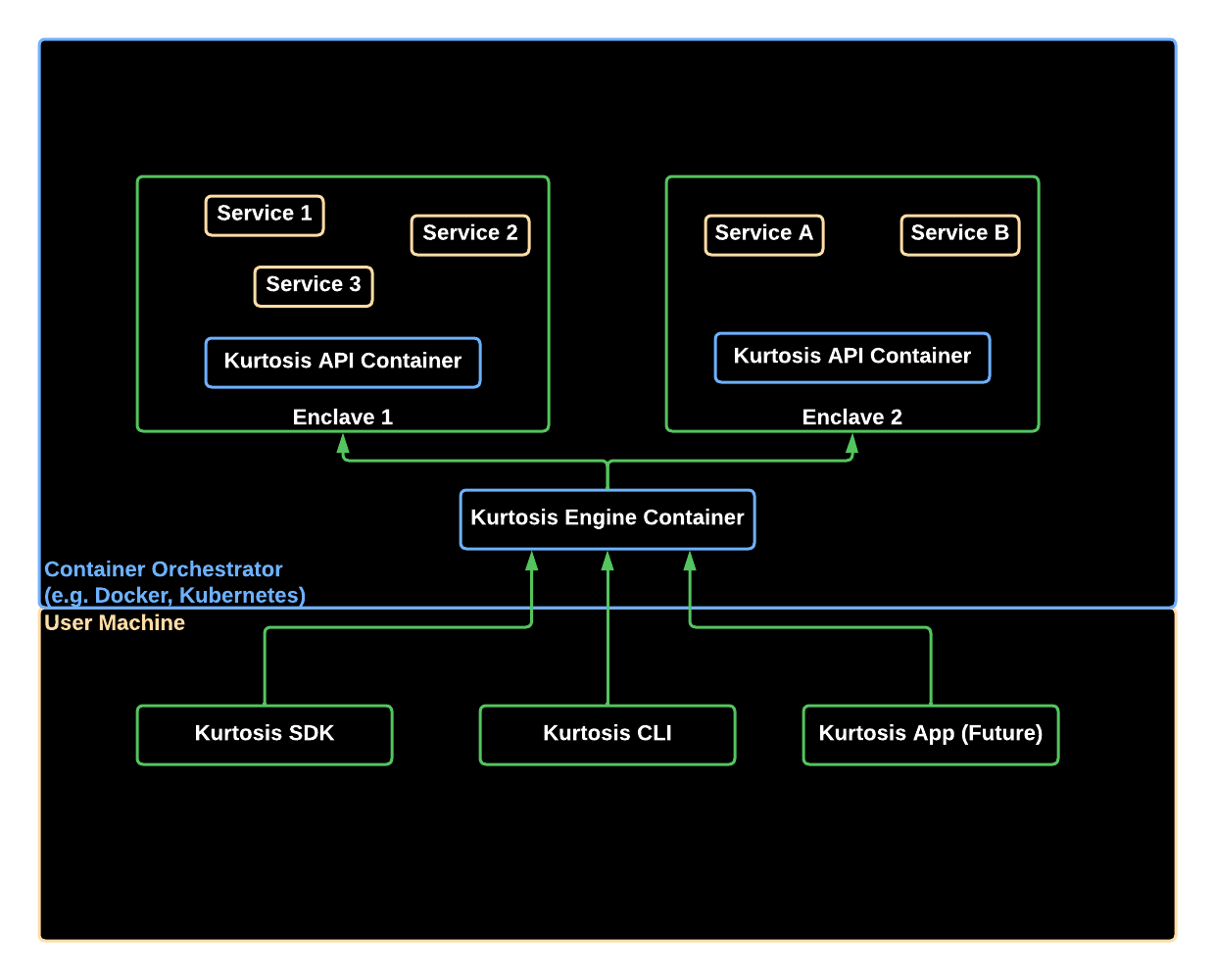Kurtosis Architecture

Kurtosis At A Macro Level
At a macro level, Kurtosis is a set of containers, deployed on top of a container orchestrator (e.g. Docker, Kubernetes), that expose APIs. All interaction with Kurtosis is done via APIs. After Kurtosis receives a request, it usually reads or modifies some state in the container orchestrator. Kurtosis therefore serves as an abstraction layer atop the container orchestrator.
One Layer Deeper
To understand what Kurtosis itself does, we'll need to understand environments. Kurtosis' philosophy is that the distributed nature of modern software means that modern software development now happens at the environment level. To respond to this need, environments are a first-class concept in Kurtosis: easy to create, easy to inspect, easy to modify, and easy to destroy.
Therefore, the job of Kurtosis is to receive requests from the user and translate them to instructions for the underlying container orchestration engine. These requests can be simple commands that map one-to-one to instructions to the underlying container orchestrator (e.g. "add service X to environment Y"), or they can be Kurtosis-only commands that require complex interaction with the container orchestrator.
Enclaves
Kurtosis implements environments as a first-class concept using enclaves. An enclave can be thought of as an "environment container" - an isolated place for a user to run an environment that is easy to create, manage, and destroy. Each enclave is separated from the other enclaves: no network communication can happen between them. Enclaves are also cheap: Kurtosis can manage arbitrary numbers of enclaves, limited only by the underlying hardware.
Example: Some enclaves running in, as displayed by the Kurtosis CLI:
UUID Name Status Creation Time
a72b68e510fe test RUNNING Thu, 30 Mar 2023 09:12:17 -03
9e8c913754bf local RUNNING Thu, 30 Mar 2023 09:13:04 -03
Engine Container
The first type of container that Kurtosis creates is the Kurtosis engine container. This container's API is principally responsible for managing enclaves. This includes creating enclaves, listing enclaves, inspecting enclaves, and removing enclaves.
Example: A Kurtosis engine container running in Docker:
bfb5627ff511 kurtosistech/engine:0.70.7 "/bin/sh -c ./kurtos…" 10 hours ago Up 10 hours 0.0.0.0:9710-9711->9710-9711/tcp kurtosis-engine--f84ce1f4c5ea410080e774cfea0ea0a4
Services
Enclaves contain distributed applications, and distributed applications are composed of services. In Kurtosis, a service is a container that exposes ports. Services may also depend on other services (e.g. an API server depending on a database). Each enclave can have an arbitrary numbers of services, limited only by the underlying hardware.
Example: A pair of Nginx services running inside an enclave called test, as reported by the Kurtosis CLI:
UUID: 2e42f9fd7b854eabb04f71a15bd1b55f
Name: test
Status: RUNNING
Creation Time: Thu, 24 Nov 2022 11:11:34 -03
========================================== User Services ==========================================
GUID ID Ports Status
nginx-1669299161 nginx http: 80/tcp -> 127.0.0.1:60785 RUNNING
nginx2-1669299176 nginx2 http: 80/tcp -> 127.0.0.1:60794 RUNNING
API Container
The second type of container that Kurtosis creates is the API container. One API container is created per enclave, and each API container is responsible for managing interactions with its own enclave. All manipulation of an enclave's contents happens via API calls to the enclave's API container.
Example: a Kurtosis API container running in Docker:
3c0b6ab7bb85 kurtosistech/core:0.70.7 "/bin/sh -c ./api-co…" 20 hours ago Up 20 hours 0.0.0.0:58419->7443/tcp, 0.0.0.0:58418->7444/tcp kurtosis-api--6babc3090ad04184b2094901a7ead7b4
Starlark
Distributed system definitions are complex. Therefore, there are many, many ways to instantiate, configure, and manipulate an enclave. To provide the required power, manipulations to an enclave are expressed using Starlark scripts.
To manipulate an enclave, users upload Starlark scripts to the API container. The API container executes the instructions in the script, and the enclave's contents will be mutated.
Example: This Starlark snippet from the quickstart launches a Postgres container:
def run(plan, args):
postgres = plan.add_service(
service_name = "postgres",
config = ServiceConfig(
image = "postgres:15.2-alpine",
ports = {
"postgresql": PortSpec(5432, application_protocol = "postgresql"),
},
env_vars = {
"POSTGRES_PASSWORD": "password",
},
),
)
For a list of all the Kurtosis Starlark instructions, see here.
SDK
All interactions with Kurtosis happen through API requests to the Kurtosis containers. To assist with calling the API, we provide an SDK in various languages. Anything the Kurtosis can do will be available via the API and, therefore, via the SDK.
To see documentation for our SDK, go here.
For day-to-day operation, we also provide a CLI. This is simply a Go CLI wrapped around the Go Kurtosis SDK.